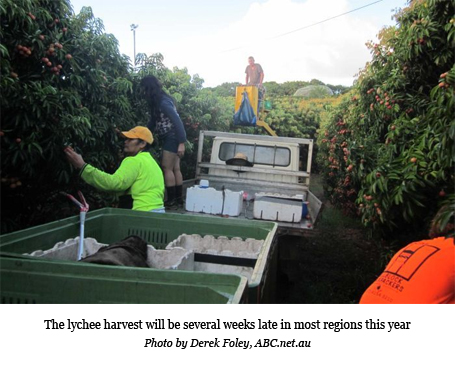by Carmen Brown, ABC.net.au
Consumers can expect to pay more for lychees this Christmas, as pickers start harvesting a lighter than expected crop in Far North Queensland.
The Australian lychee season usually begins during October, but the popular fruit is only just starting to trickle onto domestic markets now.
 President of the Australian Lychee Growers Association, Derek Foley, says cool spring conditions have delayed fruit-set in many regions, driving down crop estimates.
President of the Australian Lychee Growers Association, Derek Foley, says cool spring conditions have delayed fruit-set in many regions, driving down crop estimates.
“It’s early days, but we’re probably expecting around 1,700 or 1,800 tonnes, which is not far different from the crop we did last year,” Mr Foley said.
“These days we’re really looking for about 2,500 tonnes [nationally], but there’s been a few disappointments along the way, over the last few years with different stresses from climate.
“On average, I think it could be two weeks late across the board, some areas will vary on that obviously, but it’s certainly not going to be early.”
Lychees are traditionally most expensive in November, with prices dropping rapidly during December as production peaks.
Mr Foley says while consumers will be paying more for the fruit this festive season, growers need the higher prices to off-set lower yields.
“From a growers perspective, you’d be expecting $8 or $9 per kilogram, for pre-Christmas fruit, bearing in mind that supply is not going to be quite what it’s capable of being,” he said.
“People who have got crop, provided they have critical mass, could do quite well out of it.
“Mind you, in these hot dry conditions there is a lot of irrigating going on, and the price of electricity is less than favourable to the farming fraternity.
“Costs are always increasing, so growers are looking for a better than average price to offset those ever-spiralling increases in costs.”
First Australian lychees head to the United States
Despite a disappointing start to the season, the lychee industry is preparing to send its first trial shipment into the United States.
Mr Foley says a small amount of fruit will be irradiation-treated to meet biosecurity requirements, a process already used by mango exporters.
“We’ve actually teamed up with the mango industry to start putting some pilot shipments into the United States,” he said.
“It’s a massive market, and we’d love to think a catalyst like that would create a lot more interest in the lychee industry.
“But it’s the protocols that we have to get right before we start shifting volumes, so this program will go over the next three years.
“We’ll learn what they want, and how we can comply, and hopefully build from what I would call a solid base, rather than just a wing and a prayer.”
Source: ABC.net.au
